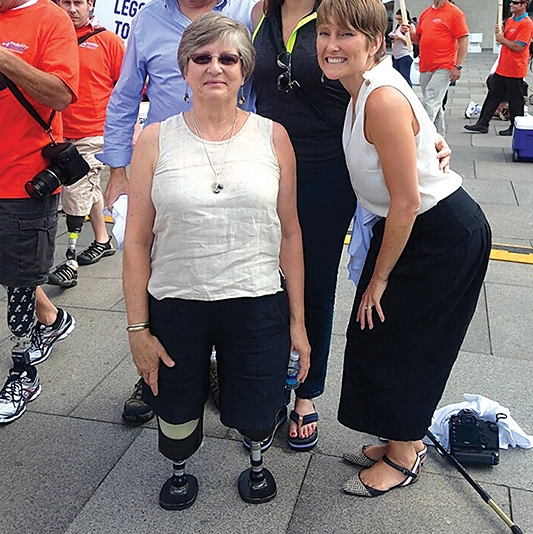By Pete Seaman, CLP

Image courtesy of Stella Sieber.
When a person is missing both legs above the knee, learning to use two prostheses with artificial knee joints can be challenging. A typical above-knee (AK) prosthesis acts like a 24-30 inch tall articulating stilt that is attached to the end of the amputee’s residual limb. It is difficult enough to get used to only one of these devices, so imagine the added effort required to learn how to use two at the same time.
One potential solution to help bilateral AK amputees begin to walk earlier, more efficiently, and more safely is to start with foreshortened prostheses, which are also known as stubbies. These devices typically consist of a socket that attaches the prosthesis to an amputee’s residual limb, a short pylon with no knee joint, and specialized prosthetic feet that look and act like small platforms. These feet are wider than standard prosthetic feet to provide enhanced stability. Additionally, the pylon that attaches them to the socket is typically located more toward the feet’s front end to place more of their surface area under the patient.
The absence of a functional knee joint makes it easier for amputees to use their prostheses as “peg legs,” which reduces the functional complications they must deal with. Because foreshortened prostheses are much shorter than regular AK prostheses, the wearers’ center of gravity (COG) is lower, and it is much easier for them to balance. Since they are closer to the ground, wearers are also less intimidated by the risk of falling, and if they should fall, the fall is usually less dangerous.
Because of their inherent functional simplicity and shorter length, foreshortened prostheses are regularly used as training devices to get new AK amputees used to wearing prostheses. Then, as their experience and confidence increase—through physical therapy and rehabilitation using the shorter devices—longer pylons can be introduced, raising the amputees’ COG. Eventually, functional knee joints and regular prosthetic feet can replace the short, fixed pylons and foreshortened prostheses for many patients. However, some amputees may choose to continue using them on a long-term basis, either part time or full time, depending on their ability to succeed with standard prostheses and their personal needs and desires.



